Palaeoxylology
Fossil wood
Wood preserved in the fossil record
Fossil wood, also known as fossilized tree, is wood that is preserved in the fossil record. Over time the wood will usually be the part of a plant that is best preserved (and most easily found). Fossil wood may or may not be petrified, in which case it is known as petrified wood or petrified tree. The study of fossil wood is sometimes called palaeoxylology, with a "palaeoxylologist" somebody who studies fossil wood.



The fossil wood may be the only part of the plant that has been preserved, with the rest of the plant completely unknown:[1] therefore such wood may get a special kind of botanical name. This will usually include "xylon" and a term indicating its presumed (not necessarily certain) affinity, such as Araucarioxylon (wood similar to that of extant Araucaria or some related genus like Agathis or Wollemia), Palmoxylon (wood similar to that of modern Arecaeae), or Castanoxylon (wood similar to that of modern chinkapin or chestnut tree).[2]